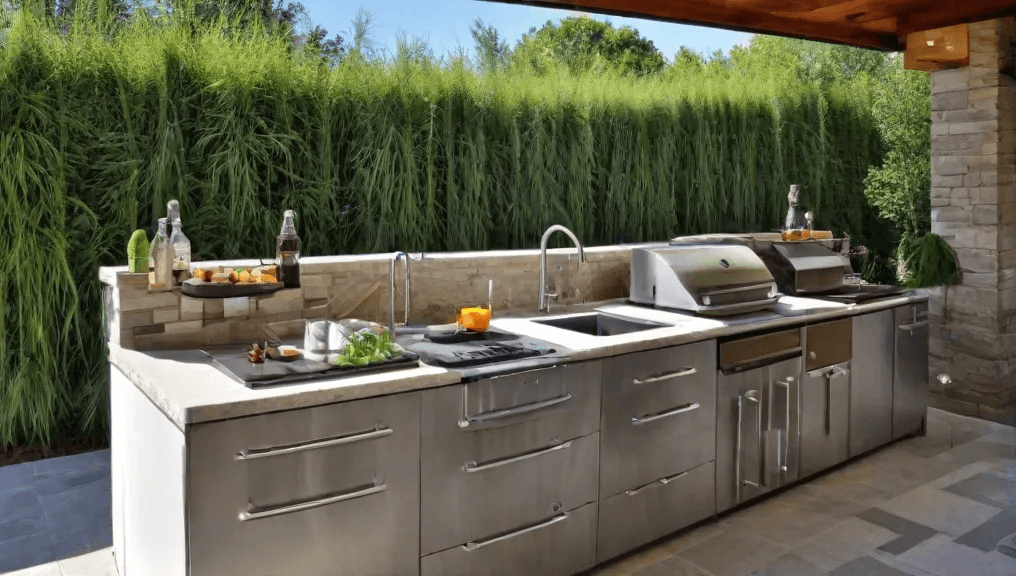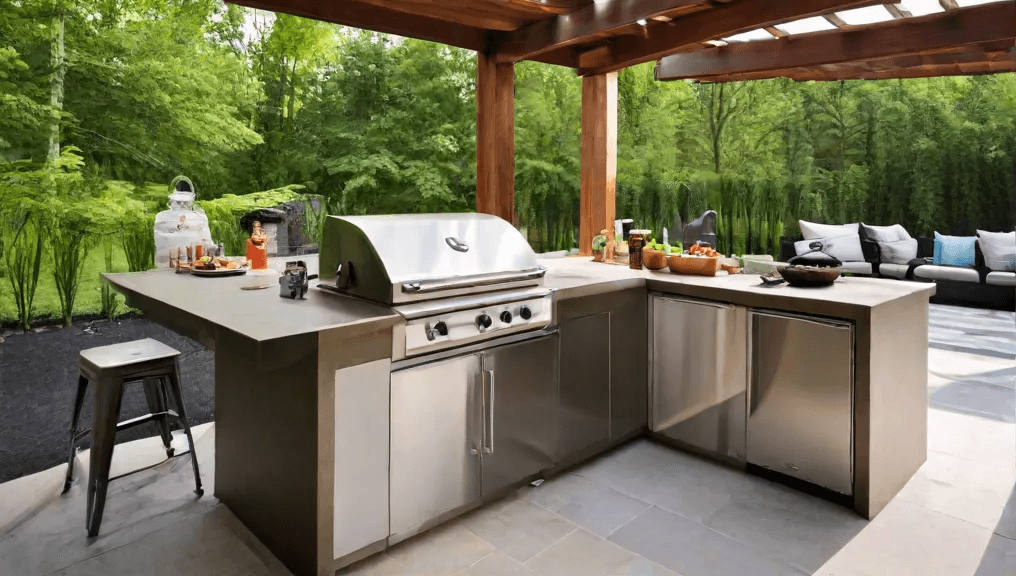Discover the benefits and essentials of outdoor kitchens. Learn how to plan, design, and maintain a functional and stylish outdoor cooking space. From choosing the right appliances and materials to creating a comfortable and inviting atmosphere, this guide covers everything you need to know to enhance your outdoor living area and increase your property’s value.

Introduction to Outdoor Kitchens
An outdoor kitchen is a designated space outside the main residence that is equipped for cooking, preparing, and enjoying meals. This innovative extension of indoor living spaces has gained significant popularity in recent years, primarily due to its numerous benefits. One of the primary advantages is the enhancement of outdoor living spaces, transforming backyards and patios into functional and aesthetically pleasing environments.
Please, read our post and do not forget to check our YouTube channel “Grig Stamate”:
https://www.youtube.com/@GrigStamate
You will find there, thousands of designing, furnishing, and decorating ideas for your home interior and outdoors.
Allow me to mention one of them:
Quick Small Patio Makeover | Outdoor Design Ideas (video)
Outdoor kitchens offer unparalleled opportunities for socializing. They provide a natural gathering place for family and friends, making it easier to host parties, barbecues, and casual get-togethers. The convenience of having a cooking area outdoors eliminates the need to shuttle between the house and the yard, allowing the host to remain part of the festivities. This integration of cooking and socializing fosters a more relaxed and engaging atmosphere, enhancing the overall entertainment experience.
Another significant benefit of outdoor kitchens is the convenience they offer. Cooking outdoors can be particularly advantageous during warmer months, as it helps to keep the heat out of the main living areas. This can lead to energy savings, as there is less strain on air conditioning systems. Additionally, outdoor kitchens often come equipped with features such as grills, sinks, refrigerators, and even pizza ovens, making them highly functional and versatile.
Beyond the immediate benefits of outdoor cooking and socializing, outdoor kitchens can also contribute to an increase in property value. A well-designed outdoor kitchen is seen as a luxury feature, often appealing to potential homebuyers. It can set a property apart from others on the market, making it a valuable investment. In essence, an outdoor kitchen enhances both the lifestyle and the financial value of a home.

Planning and Designing Your Outdoor Kitchen
Creating the perfect outdoor kitchen begins with meticulous planning and design. First, determine the primary purpose and scope of your outdoor kitchen. Are you envisioning a full-scale culinary space equipped with a grill, sink, refrigerator, and ample seating, or a simpler setup for occasional barbecues and gatherings? Defining the purpose will guide the scope of your project and ensure that it meets your specific needs and expectations.
Setting a budget is a crucial early step. Establish a realistic budget that encompasses all aspects of the project, including materials, labor, appliances, and any unforeseen expenses. A well-defined budget helps in making informed decisions and avoiding overspending. Consider consulting with a professional to get a better understanding of cost implications and potential savings.
Selecting the optimal location for your outdoor kitchen is paramount. Assess your outdoor space to find a spot that is both functional and aesthetically pleasing. Consider proximity to the indoor kitchen for convenience, as well as exposure to elements like wind and sun. The location should facilitate a smooth workflow and flow of movement, ensuring an efficient and enjoyable cooking experience.
Space requirements are another critical factor. Measure the available area and plan for sufficient space to accommodate cooking zones, preparation areas, and dining spaces. Ensure that there is ample room for movement and that the layout promotes ease of use. An effective design integrates these elements seamlessly, creating a harmonious outdoor environment.
Integrating the outdoor kitchen with the existing landscape is essential for a cohesive look. Choose materials and design elements that complement the surrounding environment, whether it’s a lush garden, a poolside, or a patio. This not only enhances the visual appeal but also ensures that the outdoor kitchen feels like a natural extension of your home.
Finally, plan for utilities such as water, gas, and electricity. These are vital for the functionality of your outdoor kitchen. Ensure that plumbing and electrical systems are safely and efficiently installed to meet the demands of your kitchen appliances. Consulting with professionals for these installations can prevent potential hazards and guarantee compliance with local building codes.
Choosing the Right Appliances and Fixtures
Creating the perfect outdoor kitchen involves careful selection of essential appliances and fixtures. One of the main attractions of an outdoor kitchen is the grill, and there are several types to choose from. Gas grills are popular for their convenience and quick heating times. Charcoal grills, on the other hand, are favored for imparting a distinct smoky flavor to food. For those seeking a versatile option, pellet grills offer the ability to both grill and smoke foods, providing a unique cooking experience.
An outdoor refrigerator is another critical component, keeping beverages and perishable ingredients fresh. When selecting an outdoor refrigerator, it’s important to choose one that is specifically designed for outdoor use, as it will be built to withstand various weather conditions and fluctuating temperatures.
Sinks also play a significant role in the functionality of an outdoor kitchen. Stainless steel sinks are a popular choice due to their durability and resistance to rust and corrosion. Additionally, incorporating ample storage solutions, such as weatherproof cabinets and drawers, can help keep your kitchen organized and protect your utensils and equipment from the elements.
Beyond the basics, consider adding specialty appliances like pizza ovens or smokers to enhance your culinary options. Pizza ovens, whether wood-fired or gas, can be a great addition for pizza enthusiasts, while smokers allow for slow-cooking meats to achieve tender, flavorful results.
When choosing appliances and fixtures for your outdoor kitchen, prioritize materials that are durable and weather-resistant. Stainless steel is a common choice due to its longevity and resistance to rust, but other options like marine-grade polymer and powder-coated finishes can also provide excellent durability.
Energy efficiency and ease of maintenance are equally important considerations. Opt for appliances that are designed to consume less energy, which can help reduce your overall utility costs. Additionally, selecting equipment that is easy to clean and maintain will ensure that your outdoor kitchen remains in top condition with minimal effort.
Selecting Materials and Finishes
Choosing the right materials and finishes is crucial when designing an outdoor kitchen. The materials must be durable, easy to maintain, and aesthetically pleasing to create a functional and attractive space. Let’s delve into the best options available for various components of your outdoor kitchen.
Countertops: When it comes to countertops, durability and resistance to weather elements are key. Granite is a popular choice due to its robustness and ability to withstand high temperatures. Additionally, it offers a range of aesthetic options with its natural stone patterns. Concrete countertops are another excellent choice, known for their customizability and industrial look. They can be treated with sealants to enhance their longevity. Stainless steel is ideal for those seeking a sleek, modern appearance and is highly resistant to stains, rust, and heat.
Cabinetry: For cabinetry, materials that can endure moisture, temperature fluctuations, and UV exposure are essential. Teak is a superior wood option, renowned for its resistance to rot and insects. It also ages gracefully, developing a silvery patina over time. Stainless steel cabinets are perfect for a contemporary look and offer unparalleled durability against rust and corrosion. Polymer cabinets, made from high-density polyethylene, are another viable option, providing an easy-to-clean, weather-resistant solution that mimics the look of wood or metal.
Flooring: The flooring of an outdoor kitchen should be slip-resistant and able to endure the elements. Stone flooring, such as travertine or slate, is both durable and visually appealing, offering a natural look that blends seamlessly with outdoor environments. Tile flooring, particularly porcelain or ceramic, is another excellent option, providing a wide range of design possibilities and ease of maintenance. Concrete flooring, with its versatility and durability, can be stained or stamped to create various textures and patterns.
Backsplashes: Adding a backsplash not only protects the walls from splashes and spills but also enhances the kitchen’s overall design. Options include natural stone, which offers a rustic, timeless appeal, and ceramic tile, known for its versatility and ease of cleaning. Stainless steel backsplashes are ideal for a modern aesthetic, providing a cohesive look when paired with stainless steel countertops and cabinetry.
When selecting materials and finishes for your outdoor kitchen, consider not only their durability and maintenance requirements but also how they complement the overall design of your outdoor space. By choosing materials that harmonize with your aesthetic vision and withstand outdoor conditions, you can create an outdoor kitchen that is both beautiful and functional.
Creating a Functional Layout
Designing a functional layout for your outdoor kitchen is pivotal to ensuring a smooth and enjoyable cooking experience. One of the key principles to consider is the work triangle, which includes the grill, sink, and refrigerator. This concept emphasizes the optimal placement of these three core elements to minimize movement and enhance efficiency. Ideally, each point of the triangle should be within a few steps of each other, forming a practical and ergonomic workspace.
When planning your outdoor kitchen, it’s crucial to think about the placement of appliances and workstations. The grill should be the focal point, positioned in a way that allows the cook to interact with guests while preparing meals. The sink should be nearby, facilitating easy access to water for cooking and cleaning. The refrigerator, essential for storing perishable ingredients and beverages, should be within reach but not obstructive.
There are several layout configurations to consider, each with its own advantages. An L-shaped layout, for example, is highly efficient, providing ample countertop space and a natural division between cooking and dining areas. This configuration is ideal for medium to large spaces. A U-shaped layout offers even more counter space and storage, creating a cohesive cooking zone that keeps all essentials within arm’s reach. This setup is particularly beneficial for larger outdoor kitchens with multiple cooks. For smaller or narrower spaces, a linear layout can be a practical solution, aligning all appliances and workstations along a single wall or counter.
Beyond the core elements, it’s important to ensure sufficient prep space, seating, and dining areas. Incorporating ample countertop space allows for easy meal preparation and serving. Additionally, consider integrating bar seating or a dining table to create a welcoming environment for guests. This not only enhances the functionality of your outdoor kitchen but also transforms it into a social hub.
In essence, a well-thought-out layout is the cornerstone of a successful outdoor kitchen. By prioritizing the work triangle, optimizing appliance placement, and ensuring adequate prep and dining spaces, you can create an outdoor kitchen that is both functional and inviting.
Incorporating Comfort and Ambiance
Creating a comfortable and inviting atmosphere in your outdoor kitchen is essential to ensure it becomes a space where everyone loves to gather. To start, consider the seating options that will best suit your needs. Whether you opt for built-in benches, cushioned lounge chairs, or a combination of both, make sure there is ample seating for guests. Adding outdoor-friendly cushions and throws can provide extra comfort and a touch of style.
Shade structures are vital for protecting against the elements and setting a cozy scene. Pergolas, umbrellas, and retractable awnings offer adjustable shade, allowing you to control the amount of sunlight in your outdoor kitchen. These structures not only provide comfort but also contribute to the overall design aesthetic.
Weather protection is another crucial factor. Heaters and fans can extend the usability of your outdoor kitchen through different seasons. Patio heaters, whether propane or electric, ensure warmth during cooler evenings, while ceiling or portable fans help keep the area cool and comfortable during warmer months.
Lighting plays a significant role in enhancing both ambiance and functionality. Task lighting, such as under-cabinet lights or LED strip lights, is essential for cooking and food preparation areas. Ambient lighting, like string lights or lanterns, creates a warm and inviting atmosphere. Accent lighting, including spotlights or pathway lights, can highlight architectural features and add a layer of sophistication to your outdoor space.
To further elevate the experience, consider integrating a sound system. Outdoor speakers or wireless sound systems can provide background music, setting the perfect tone for entertaining. Additionally, incorporating decorative elements like outdoor rugs, potted plants, and artwork can personalize the space and make it feel more like an extension of your indoor living area.
By thoughtfully incorporating these elements, your outdoor kitchen will not only be functional but also a comfortable and inviting retreat for all your entertaining needs.
Outdoor Kitchen Safety Tips
Ensuring safety in your outdoor kitchen is paramount to creating an enjoyable and secure cooking environment. One of the first considerations is proper ventilation, particularly for gas appliances. Without adequate airflow, harmful gases can accumulate, posing serious health risks. Therefore, it is essential to install ventilation hoods or fans to disperse fumes effectively.
Handling and storing propane tanks also require careful attention. Always keep propane tanks upright and in a well-ventilated area. Avoid storing them indoors or near any source of ignition. Regularly inspect the tanks and hoses for leaks or signs of wear, and replace them if necessary.
Fire extinguishers are another crucial component of outdoor kitchen safety. Having a fire extinguisher readily accessible ensures that you can respond quickly to any unexpected flare-ups. Make sure that everyone using the kitchen knows where the extinguisher is located and how to use it.
Electrical safety is equally important. Outdoor kitchens often require the use of electrical appliances, making the installation of Ground Fault Circuit Interrupter (GFCI) outlets a necessity. These outlets are designed to prevent electrical shock by shutting off power when an imbalance is detected. Additionally, ensure that all wiring is up to code and protected from the elements to prevent hazards.
Maintaining cleanliness in your outdoor kitchen is not only a matter of hygiene but also of safety. Regular cleaning helps to prevent accidents caused by grease buildup and reduces the risk of pests being attracted to leftover food. Store food securely and promptly clean up spills to keep the area safe and inviting.
By following these essential safety tips, you can create a secure and enjoyable outdoor cooking space that you and your guests can enjoy with peace of mind.
Maintenance and Care of Your Outdoor Kitchen
Maintaining your outdoor kitchen is essential for ensuring its longevity and optimal performance. Regular upkeep not only preserves the aesthetic appeal of your space but also enhances the functionality of your appliances and surfaces. Here are some key maintenance practices to keep your outdoor kitchen in pristine condition.
First, establish a routine cleaning schedule tailored to the different materials in your outdoor kitchen. For stainless steel surfaces, use a non-abrasive cleaner and a soft cloth to prevent scratches and maintain the metal’s shine. Stone countertops, such as granite or marble, should be sealed annually and cleaned with a pH-neutral cleaner to avoid etching. Wooden components, like cabinetry or decking, require periodic sealing or staining to protect against moisture and UV damage.
Appliances such as grills, refrigerators, and sinks also demand specific care. Clean grill grates after each use to prevent buildup of grease and food particles, which can cause corrosion and affect performance. Refrigerators and coolers should be defrosted and sanitized regularly to maintain proper temperature control and hygiene. Sinks and faucets benefit from routine descaling to avoid mineral buildup, particularly in areas with hard water.
Seasonal maintenance tasks are crucial for preparing your outdoor kitchen for changing weather conditions. In colder climates, winterize your kitchen by disconnecting water lines and draining appliances to prevent freezing damage. Covering grills and furniture with weather-resistant covers protects them from snow and ice. During the warmer months, inspect for any signs of wear and tear caused by exposure to sun and rain, such as rust or fading, and address them promptly.
Extreme weather conditions pose additional challenges. High winds can damage structures and appliances, so secure all movable items and consider installing windbreaks. In areas prone to heavy rainfall or flooding, ensure proper drainage around your outdoor kitchen to prevent water damage.
Regular inspection and servicing of your kitchen appliances are paramount to prevent issues and extend their lifespan. Check gas lines, electrical connections, and plumbing for any signs of leaks or damage. Professional servicing at least once a year ensures that your appliances function safely and efficiently.
By following these maintenance and care guidelines, you can enjoy your outdoor kitchen for years to come, making it a valuable extension of your living space.
Other related posts from our website:
https://howtobuildahouseblog.com/transforming-your-outdoor-kitchen-into-a-luxurious-oasis/
https://howtobuildahouseblog.com/when-is-a-good-time-to-start-building-an-outdoor-kitchen/
https://howtobuildahouseblog.com/how-to-build-an-outdoor-kitchen/
Thank you so much for your attention.
Stay tuned. We will upload many other amazing posts to our website and videos onto our YouTube channel.
Thank you so much.
for your time and attention.
Best Regards
See you to another post,
Bye, Bye



No Responses